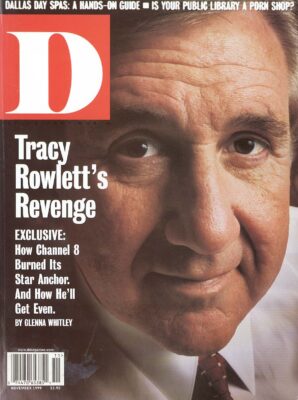“I’VE GOT A BIG NEW CHURCH AND you won’t believe which congregation!” said Philip Johnson on the phone to a friend.
“Seventh Day Adventists?” ventured the voice on the other line.
“No! Worse than that: the largest gay and lesbian church in the world and it’s right there in Dallas. They want 2,500 seats, just a little smaller than Schuller’s Crystal Cathedral. What will Peter Stewart think?”
In 1996, after years of producing big, bottom-line commercial structures with John Burgee, Philip Johnson was enjoying approval in The New York Times for his “Monster in Connecticut.” In Dallas, Johnson was redesigning parts of ThanksGiving Square for Peter Stewart, who wanted to embellish the triangular park with spiritual art.
The New Yorker’s “Talk of the Town” reported in the fall of 1997 that Philip Johnson was back and in new offices in the Seagram Building and had resumed greeting friends and lunching at his regular banquette. No. 32, in the Four Seasons Restaurant. He was soon back at work on his largest project, his sixth religious structure.
THE Reverend Michael Piazza of Dallas has bright red hair and is a persuasive, articulate speaker. Diminutive in stature with a forceful, winning self-confidence, he came to Dallas in 1987 from a gay congregation in Florida, not expecting to stay here more than five years. His gay and lesbian congregation, a member of the nationwide Metropolitan Community Churches, expanded rapidly under him, outgrowing its building in the Cedar Springs part of Oak Lawn, an older residential neighborhood between the downtown district and the affluent Park Cities farther north.
Piazza was frustrated by his efforts to buy vacant, larger church buildings. The owners were conservative or fundamentalist and wouldn’t sell to a gay church. He says that he was further thwarted when he wanted to build; most building contractors had ties to the Baptist church and wouldn’t negotiate with Piazza. He finally purchased land in foreclosure, bounded by commercial property near Love Field. A contractor from Tyler in East Texas agreed to build a new church, to be called The Cathedral of Hope, and Piazza and others in the congregation designed the 800-seat church with the help of the contractor and dedicated it in early 1993.
Piazza says, “By Christmas of 1994, the congregation had become so large that it was clear that we couldn’t grow in that church and had to do something!
“Shortly afterwards, I attended a conference on problems of congregation growth at Dr. Robert Schuller’s church in Garden Grove, Calif., the Crystal Cathedral. Schuller spoke of his architect and his great building as something that embodied Schuller’s vision and ’captured the imagination’ and I began to wonder if this architect who had built a house of glass in earthquake country could do something special for us. Schuller is probably the best-known man in the Western world due to his daily TV coverage in every country; the network plus the building made Schuller.
“After I walked out, a colleague came up to me and said, ’You know Philip Johnson is a gay man, don’t you?’ I didn’t know that. I knew he was an architect, but I didn’t know he was gay; but that was the final piece to make it come together. I returned to Dallas knowing what I had to do.”
Johnson’s sexuality had been speculated about for years, particularly among architects, and though his close circle knew he was homosexual, he maintained a show of conventional behavior until the reported scolding by Barbara Walters, who told him one night that he should stop the deception and start bringing David Whitney with him to dinner parties, which he did forthwith and never retreated. (Johnson: “Never look back is the first principle!”)
At the time David Whitney, a highly regarded curator of contemporary art, had been with him for over 30 years and was in charge of Johnson’s art collection.
Michael Piazza returned to Dallas and suggested to his board that they think about a much larger building even though their new church was only a few years old and still being paid out. They authorized him to write Johnson, but Johnson answered saying he couldn’t do the job, “You might not know it, but I’m 89 years old.” Piazza felt he hadn’t explained enough so he went to New York to see Johnson in person.
Johnson interrupted a conference and met Piazza for what was supposed to be a 10-minute meeting. “He said, ’I’m sorry I wasn’t able to do your project, but I’m old and church projects lake a long time. Tell me about your church.’ I started telling him about The Cathedral of Hope, about why I wanted it to be more than a church and about its importance to history and the difference it will ultimately make in the world. It’s so important for it to be a symbol of inclusion and that our intent was nothing less than changing the way the world feels about lesbian and gay people and the way that lesbian and gay people feel about each other and to begin to reclaim Christianity from some of the fundamentalists. Thirty minutes later he said, ’How can I not do this?’ and, surprised, I said ’Are you saying yes? Are you telling me you will do this project?’ He said, ’Oh yes, we will do it. How do we get started?’ I told him 1 would like to announce his selection as architect at the church’s 25th anniversary service and would like for him to be there. He stepped outside the room and cancelled a conflicting trip to Alaska.”
It is like an
THE ANNIVERSARY SERVICE, WHICH attracted the entire Cathedral of Hope membership, was held in the Meyerson Symphony Center, completed in 1989, by I.M Pei. (Johnson had been interviewed for the building but was passed over.) Piazza kept secret from everyone his plan to introduce Johnson, recounting the way the church’s new architect was selected; first his refusal to do the job, then after hearing Piazza out, his enthusiastic agreement. Then Piazza said, “And now I would like to introduce our new architect, Philip Johnson and his partner of 35 years, David Whitney.” The huge hall erupted with a roaring, standing ovation as Johnson stood in the loge level beside Whitney and waved to the cheering crowd in the orchestra below and the balconies above. It was a stunning, formal “outing” for the world-famous architect, approaching 90 and publicly at peace with his nature.
The first design, while free in form and similar in spirit to Johnson’s Visitors Center featured a fan-shaped seating plan and, sprawling in the “wanton mode,” was dubbed “the frog.” No one liked it, including Piazza. The second one was a rectilinear shape, resembling Washington’s Kennedy Center, with a colonnade-supported roof and an interior of closely spaced “columns,” suspended from the ceiling above eye level. It was striking in concept but also rejected. Next was another free-form concrete structure, divided by an entry, and also abandoned; the final scheme was a simplified but also a sculpturally intensified version of the third. It was compared to an ark, an iceberg, and the Rock of Gibraltar.
ark, an iceberg and the Rock of Gibraltar.
The Cathedral of Hope is a massively modeled form of shelter and grandeur rising from a low point at the entry to 117 feet at the prow-like upper part of the sanctuary above the altar. The shape follows roughly the restricting descending flight path to the airport to the west. The concrete walls are folded and heavily pleated in a highly abstract way, the pleats forming “buttresses” reminiscent of the supporting walls of early New Mexico adobe churches. A tall, broad bell-tower screen, attached to a rambling covered cloister, abuts and mitigates the remodeled existing church. A small bio-morphic chapel attaches to one side of the sanctuary’s lobby like an aneurysm. The weaving and waving interior walls, widiout right angles or parallel lines, ascend to the 100-fooi-high altar wall below the great space’s skylight, concealed behind a floating ceiling. “We have architecture now that pulls and bends around you-like your body-no right angles, no straight lines,” Johnson has said, and he illustrates it in this new cathedral.
It is the formal converse to die transparent Crystal Cathedral: one tautly transparent, the other billowing and opaque. Dr. Schuller’s church possesses rigorous geometry; the Dallas building is an expressionist sculpture, simultaneously exuberant and somber. The nearly windowless space envelops and protects as it liberates and soars. A champion of the ever-new in architecture-particularly if it was a new interpretation of the expression-ionist Finsterlin’s unbuilt designs of the ’20s and with antennae super sensitive to the Zeitgeist, Johnson proved himself again to the despair of those who prize consistency and neo-expressionism as design doctrine.
At a groundbreaking in 1999 for the bell-tower wall, when the congregation had pledged $6 million of the $20 million required for construction, Johnson, 92, was quoted, “I keep telling them to hurry up! Twenty million dollars for a building like this is not expensive. Once people see it going up they’ll rush in to help complete it. But they want a few more dimes in the box first.
’I’m doing real architecture again,” he goes on. “No more kicking around bits of history. No more skyscrapers. Churches and synagogues are the only buildings worth doing, unless, of course, I’m doing something for myself.”
Many of Johnson’s patrons, colleagues, friends and friendly foes died during the ’90s. Lincoln Kirstein, his longtime friend and patron since Harvard, died in 1994; Paul Rudolph, Brendan Gill, and Isaiah Berlin died in 1997. Berlin, a celebrated philosopher and lecturer at Oxford University who spent a lot of time in the U.S. and enjoyed a social friendship with Johnson, says, “We would see each other at a dinner party and spend the entire evening with our heads together to the despair of the hostess. We didn’t agree on politics, but that didn’t matter; we just ignored that part–there was too much else to talk about.”
Berlin’s theories of the values of pluralism in our society were the philosophical equivalent of Johnson’s longtime advocacy of the value of multiple sources for postmodern, contemporary architecture.
Get our weekly recap
Brings new meaning to the phrase Sunday Funday. No spam, ever.
Related Articles

Restaurants & Bars
The Best Japanese Restaurants in Dallas
The quality and availability of Japanese cuisine in Dallas-Fort Worth has come a long way since the 1990s.
By Nataly Keomoungkhoun and Brian Reinhart

Home & Garden
One Editor’s Musings on Love and Letting Go (Of Stuff, That Is)
Memories are fickle. Stuff is forever. Space is limited.
By Jessica Otte

Football
The Cowboys’ Draft Class Is Heavy on Athleticism and Heavier on Beef
Dallas entered the weekend needing help on both lines. It exited with plenty of fresh faces to plug those gaps.
By Dan Morse


